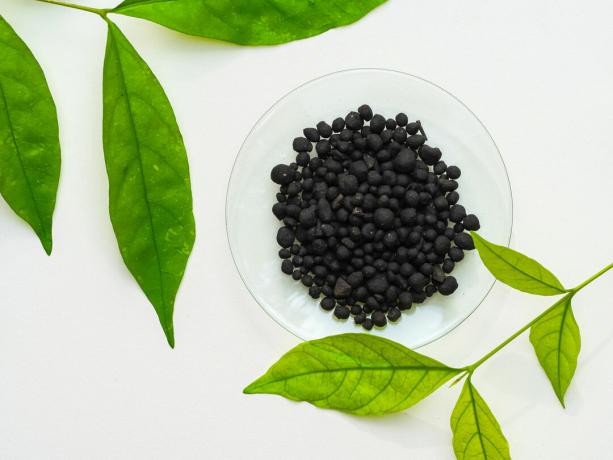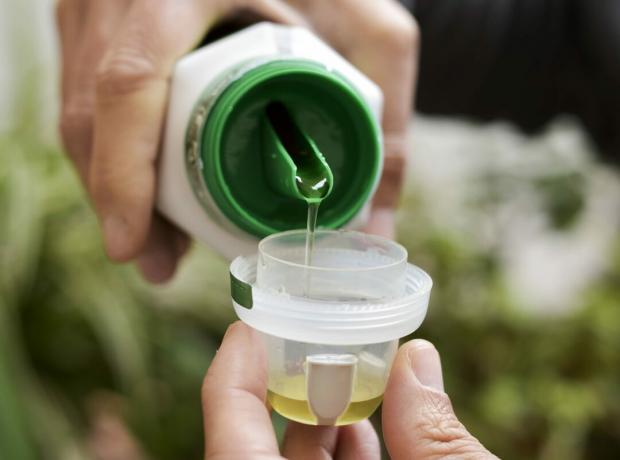Guano as an additive in fertilizers is eagerly advertised. But what exactly is guano and what does it bring to plants?

Behind the melodic-sounding name “Guano” hides a fertilizer made from animal excrement, which has been known for a long time and wars have even been fought over. This is particularly popular because of its high nitrogen and phosphorus content. The origins of guano are in South America. Only at the beginning of the 19th In the 19th century this fertilizer came to Europe. We have compiled more about guano fertilizers for you below.
contents
-
What is guano anyway?
- Origin and properties of guano
- Cons of guano
- Guano from bats
-
Guano as a fertilizer
- Apply guano fertilizer
- How do you use guano fertilizer?
- Dosing of guano fertilizer
- Buy guano fertilizer
- Is guano poisonous?
Guano is often advertised as an organic super-fertilizer, but unfortunately that does not exactly correspond to reality. What you need to know about guano and how it works as a fertilizer can be found here.
What is guano anyway?
Guano is simply feces from different animals. Guano was first discovered in the areas around the west coast of South America (Chile, Peru) and came from sea birds such as pelicans and cormorants.
Origin and properties of guano
The first samples of guano found their way from Peru to Europe as early as 1804. Alexander von Humboldt carried out the first chemical investigations of guano in Paris. The first large shipments of guano arrived in Great Britain in 1840 and made their way to Germany for the first time in 1841. But this fertilizer has an eventful history behind it: There have even been wars over regions with high levels of guano in South America. Although the fertilizer was initially hotly contested, demand fell with the invention of the Haber-Bosch process.

Because with this process it was possible to extract nitrogen from the air and use it as fertilizer. As a result, the need for fertilizers from South America decreased. Before we Europeans, however, the Incas had already discovered that this bird droppings can be used as fertilizer and thus increased the yield on their fields. However, the Incas dismantled this material with a sustainable thought. They only took as much guano as could be regenerated - in contrast to later commercial degradation of the bird droppings, which strongly fluctuates the equilibrium of this ecosystem brought.
Cons of guano
The environment of the guano areas was severely damaged by its mining. Two wars were even fought over this raw material, which went down in history as the Spanish-South American and the saltpeter war. The coasts served as breeding grounds for these animals, as a result of which meter-thick layers of excrement accumulated. This manure was then broken down as fertilizer and shipped to Europe. As a result, the penguins there in particular suffered greatly. The penguins dig their breeding caves in the guano and lost their breeding grounds due to the commercial mining of guano. This led to severe damage to the animal population. This irresponsible guano mining has severely damaged the ecosystem. The transport of guano across half the globe is also not very sustainable. The working conditions of the local guano producers are also often described as inhumane. So it becomes clear that guano is very stressful for nature and not necessarily resource-saving. Therefore, it is better to use locally produced, mainly organic fertilizers, which have a lower impact on the environment - like ours Plantura organic fertilizer.
Guano from bats
There is also guano, which is produced by bats. Compared to bird guano, however, the yield from a bat colony is rather low. Further problems are the management and mining of bat guano, because the caves are usually not very easy to reach. However, should you have bats in your attic, you can enjoy the free fertilizer that is building up there.

Guano as a fertilizer
With regard to the composition, a distinction has to be made between red and white guano. The red guano occurs fossil and has a phosphoric acid content of 20 to 30%, as it is a lot older than the daily guano. It is used as an organic fertilizer and is often used in organic farming as a phosphorus fertilizer. White guano, on the other hand, is the animals' faeces produced every day and has a nutritional composition of 10 to 12% nitrogen, 10 to 12% phosphorus and up to 3% potassium. The nutritional composition of the fertilizer varies depending on the species of animal that produces the guano. The differences in the NPK ratio (i.e. in the nitrogen-potassium-phosphorus ratio) can be clearly seen:
- Bat guano (nitrogen stressed): 10 - 3 - 1
- Bat guano (phosphorous): 3 - 10 - 1
- Sea bird guano (nitrogen stressed): 12 - 8 - 1
- Sea bird guano (phosphorous): 1 - 10 - 1
Apply guano fertilizer
Now you have already learned a lot about the origin and composition of guano fertilizer, but how do you use this fertilizer? The correct application of course depends on the form of your fertilizer. Guano is available as powder or granulate as well as liquid fertilizer and there are even fertilizer sticks that contain guano.

Most of the time, however, guano is found in organic fertilizers as an admixture to increase the nitrogen and phosphorus content. Because of the guano, the fertilizers have a higher nutrient content. However, you can also simply use mainly organic fertilizers with long-term effects without guano, such as ours Plantura organic universal fertilizer.
How do you use guano fertilizer?
If you use guano in solid form, you should always work the fertilizer into the soil. After application, it is advisable to water the soil properly. Another promising method is the immediate introduction when planting. When planting out, simply add a teaspoonful of guano fertilizer to the planting hole. This means that the fertilizer is exactly where it is needed - at the roots of your plants. Liquid guano fertilizers are mostly mixed with the irrigation water. Pay attention to the instructions for use of the respective product. There are already fertilizer sticks with guano on the market and they are easy to use. You simply take a stick out of the package, insert it into the soil a few centimeters from the edge of the pot and the fertilization is done. These sticks release the fertilizer over a longer period of time. This saves you the constant re-fertilization, especially for balcony or potted plants. Guano fertilizer is generally used for all plants in the garden or in the house. It is best used from March to September.
Dosing of guano fertilizer
When dosing fertilizers, you should always first of all observe the product information. In principle, you can't go wrong with 40 g solid guano fertilizer per m² in spring or before sowing. If necessary, you can re-fertilize with the same amount in summer. One kilo of an organic fertilizer with guano admixture, which has a nutrient ratio of 7-3-4, is approximately sufficient for 33 m³ of soil. This corresponds to an amount of fertilizer of around 30 g per m³ of soil.

With liquid fertilizers, simply dilute the fertilizer solution in the irrigation water. Before use, it is important to shake the bottle well so that the sediment dissolves and mixes. Often you can do the dosage with the lid, because there are notches there for measuring the amount of fertilizer. For example, if you use a liquid guano fertilizer with an NPK ratio of 7 - 3 - 6, you should adhere to the following dosages:
- For balcony and terrace plants, you should use 10 to 15 ml of liquid fertilizer per liter of irrigation water once a week.
- For indoor plants, 5 ml of liquid fertilizer per liter of irrigation water is sufficient once a week. In winter you have to fertilize much less often - depending on the type of plant.
When it comes to fertilizers, however, always keep in mind that there are crops that need more nutrients and others that get by with less. You should therefore always read the manufacturer's information and find out about your plants' nutritional requirements in our special articles.
Buy guano fertilizer
Various fertilizers containing guano are available on the market. It is often advertised with the argument that this fertilizer is organic. It is of course true that the fertilizer is made from natural ingredients and does not contain any synthetically manufactured components. However, it is questionable whether it is biologically justifiable.

One should keep in mind that the sea bird guano has come a long way before it ends up in our garden and is repeatedly interfered with in an existing ecosystem through degradation. If sustainable gardening is important to you, then give ours a try Plantura organic fertilizer the end.
Is guano poisonous?
Ingesting fertilizer is generally not a good idea, but if you have inhaled any guano manure residue, it is definitely advisable to go out into the fresh air. In the event of skin contact, it is sufficient to wash the area thoroughly with soap and water, and in the event of contact with the eyes you should rinse them thoroughly for 15 minutes. If you accidentally swallow the fertilizer, rinse your mouth out with water and then drink plenty of water. If you come into contact with the fertilizer and feel uncomfortable afterwards, you should always consult a doctor.
More and more people are using animal-free products in their gardens. In this article we will introduce you to the benefits and ingredients of vegan fertilizers before.
